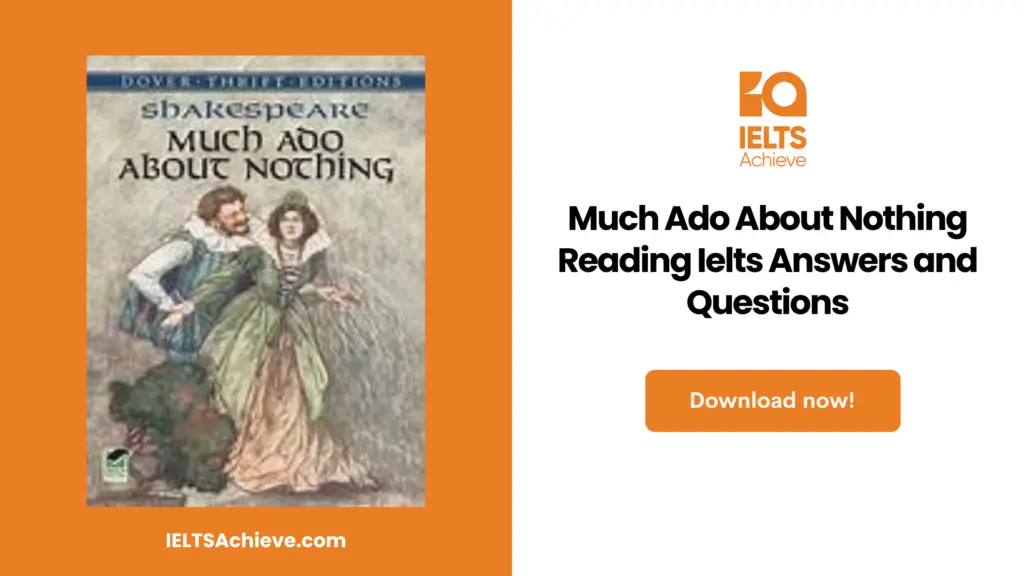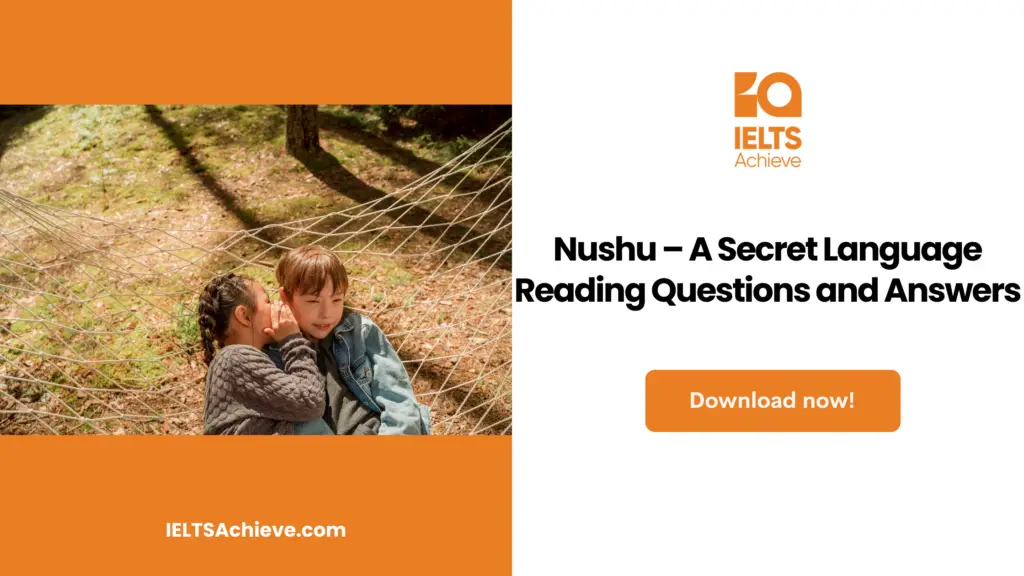The Blog post contains the following IELTS Reading Questions:
- IELTS Reading Matching Features
- IELTS Reading Sentence Completion
- IELTS Reading Summary Completion
Stay informed and prepared for success – Explore our comprehensive Reading Test Info page to get valuable insights, exam format details, and expert tips for mastering the IELTS Reading section.
Much Ado About Nothing Reading Passage

Much Ado About Nothing
The controversy surrounding genetically engineered food can teach people involved in nanotechnology several important lessons.
- “The time has passed for discussing the benefits and drawbacks of GM crops. The commercialization of GM crops will become an undesirable alternative due to severe and persistent economic intimidation.”
- These are the kind of statements made in an article in the most recent issue of Earth First!, a radical environmental publication, that give people working to commercialise biotechnology the sweats. For the most part, those concerned, the level of public opposition to genetically modified organisms (GMOs) came as a shock and surprise. Some are now speculating as to whether nanotechnology, which refers to the manipulation of matter at sizes of a millionth of a millimetre, would experience a similar reaction and, if so, whether its proponents might draw any lessons from the public’s opposition to biotechnology.
- Gain of Doom
- Jeffrey Matsuura, a law professor at the University of Dayton in Ohio, was present at a Nanotech conference held in Boston last week, but he was hidden away in a forgotten corner with his unassuming poster of his work. But everyone in attendance needed to consider his warning, especially the investors who were searching the conference for investment opportunities. And the reason for this is that nanotechnology is already influenced by a number of the reasons that led to a popular backlash against biotechnology. According to Dr. Matsuura, biotechnologists believed that the general population would recognise and value biotechnology’s promise to enhance quality of life right away. Instead, the risks caught the media’s and a large portion of the public’s attention. Well-fed The idea of cheaper food, in particular, was regarded with skepticism by European customers. Many believed that the hazards associated with cultivating and ingesting the crops would be borne by the general public, while the benefits would go to the businesses that had produced GMOs.
- According to Dr. Matsuura, the public’s opinion of nanotechnology is evolving in a similar manner. The initial uses of nanotechnology, like those of biotechnology, won’t have many overt advantages for consumers. Reduced applications of agricultural chemicals, which assist to keep the cost down while improving yields, are reminiscent of the “advantages” of biotech, as are better, cheaper materials and hidden production efficiencies that benefit producers initially. Consumer gains that are immediately apparent, like advancements in medicine, are further off.
- This is unnecessary because consumers ultimately gain from cost savings as well. However, in combination with the perception that there are risks, a lack of instant advantages could quickly sway public opinion against nanotech. And there are possible risks. It is absurd to worry about uncontrollable, self-replicating “nanobots” that would ultimately consume and turn the entire planet into “grey goo.” It is still possible for new “nanoparticles” to pose serious toxicological risks.
- Nanoparticles are so tiny that they might stick to the lungs if ingested. They are theoretically tiny enough to get inside living cells and build up there. In addition, at a Royal Institution presentation in London in January, Ken Donaldson, a professor of respiratory toxicology at the University of Edinburgh, demonstrated that ultrafine carbon particles can enter the bloodstream and travel to the brain after inhalation.
- Nanoparticle-based goods, including sunscreen and auto components, are already widely available. Despite the fact that all of this might sound concerning, people have always been subjected to various types of nanoparticles throughout history. For instance, carbon particulates comprise soot. Yet, nanoparticles from sources including diesel soot, photocopier toner, and welding gases are already connected to ill-health. Many people are probably concerned about the possibility of more such particles. It makes sense that several speakers at the Boston conference referred to the need to “aggressively” handle public concerns about nanotechnology.
- One of them was Clayton Teague, the National Nanotechnology Coordination Office’s director in America. He claims that just like any other member of the public, the American government is sensitive to any indication of a real health danger. The risks of nanotechnology to the ecosystem and to human health are currently the subject of numerous sizable and well-funded studies.
- Dr. Teague adds that any choices made regarding nanotechnology will be carefully considered and supported by reliable scientific evidence. But even if science approves, one of Dr. Matsuura’s lesson is that this might not always prevail and that concern over possible abuses and accidents may end up dictating the conversation.
- Dr. Matsuura suggests, among other things, that everyone participating should convey the same message. A person who is worried about the hazards cannot be informed that a technology is unimportant after being told that it would transform the world by investors. Saying that anything may be both innovative and unimportant strikes the wrong tone, in his opinion. Such contradictions will increase public worry and suspicion.
- Product Placement
- Donald Reed is a senior consultant with Ecos in Sydney, Australia-based company that serves as a middleman between businesses and activists. Mr. Reed even advises businesses to consider the early commodities they decide to develop, namely whether they can show the “societal value” of these products. One early application of nanotechnology, for instance, might be the development of inexpensive, effective photovoltaic materials, which are used to produce power from sunlight.
Unlock your full potential in the IELTS Reading section – Visit our IELTS Reading Practice Question Answer page now!
Recommended Questions:
Renewable Energy IELTS Reading Question with Answer
Much Ado About Nothing IELTS Reading Questions
Questions 1-4
Take a look at the following people with the list of statements below. Choose the appropriate statement for each individual.
- Clayton Teague
- Ken Donaldson
- Donald Reed
- Jeffrey Matsuura
List of statements:
- Factors that led to resistance to biotechnology are having an impact on nanotechnology.
- The majority of the benefits of nanotechnology growth will go to Europeans.
- Any decisions regarding nanotechnology will be made on the basis of reliable scientific evidence.
- Governments are powerless to influence the advancement of nanotechnology.
- There’s no need to be alarmed about nanotechnology.
- When inhaled, carbon nanoparticles can travel to the blood flow and brain.
- Companies should demonstrate the social benefits of their early nanotechnology items.
Improve your performance in Matching Features questions by clicking here to access our comprehensive guide. Learn how to match specific features or characteristics with the options provided in the IELTS Reading section.
Questions 5-8
Complete the sentences given below. For each answer, choose NO MORE THAN THREE WORDS from the paragraph. Fill in boxes 5 – 8 on your answer sheet with your responses.
5. Those who were employed there were shocked to learn that the general public strongly disapproved of __________. 6. Europeans responded to the suggestion of cheaper food with __________. 7.Nanobots, which could one day alter the Earth is _____________, are causing people anxiety. 8. Photocopier toner nanoparticles have already been tied to _________.
Enhance your sentence completion skills in the IELTS Reading section. Click here to access our comprehensive guide and learn effective strategies for filling in missing words or phrases in sentences.
Questions 9-13
Using the letters from A-L listed below, complete the summary.
Some individuals think that nanotechnology might have the same 9. ____________fate as biotechnology. Rather than celebrating the 10. _____________, the media and a lot of the general public concentrate on the 11. _______________of biotechnology. Therefore, it is crucial to underline the immediate 12. __________ of nanotechnology; otherwise, the public may develop a 13. _______________ towards nanotech. Hence, it’s critical that everyone involved maintain consistency.
| A. Worse | B. Greater | C. Devices | D. Particles |
| E. Costs | F. Latter | G. Dangers | H. Thoughts |
| I. Advantage | J. Former | K. Attitude | L. Comparable |
Boost your performance in Summary, Notes, Table, and Flowchart Completion tasks. Click here to explore our detailed guide and learn how to effectively complete summaries, notes, tables, and flowcharts in the IELTS Reading section.
Unlock your full potential in the IELTS Reading section – Visit our IELTS Reading Practice Question Answer page now!
Recommended Questions:
Renewable Energy IELTS Reading Question with Answer
Much Ado About Nothing Reading Answers
1. C
2. F
3. G
4. A
5. genetically modified organism/ GMOs
6. skepticism
7. absurd|
8. ill- Health
9. L
10. F
11. G
12. I
13. K

We hope you found this post useful in helping you to study for the IELTS Test. If you have any questions please let us know in the comments below or on the Facebook page.
The best way to keep up to date with posts like this is to like us on Facebook, then follow us on Instagram and Pinterest. If you need help preparing for the IELTS Test, join the IELTS Achieve Academy and see how we can assist you to achieve your desired band score. We offer an essay correction service, mock exams and online courses.

